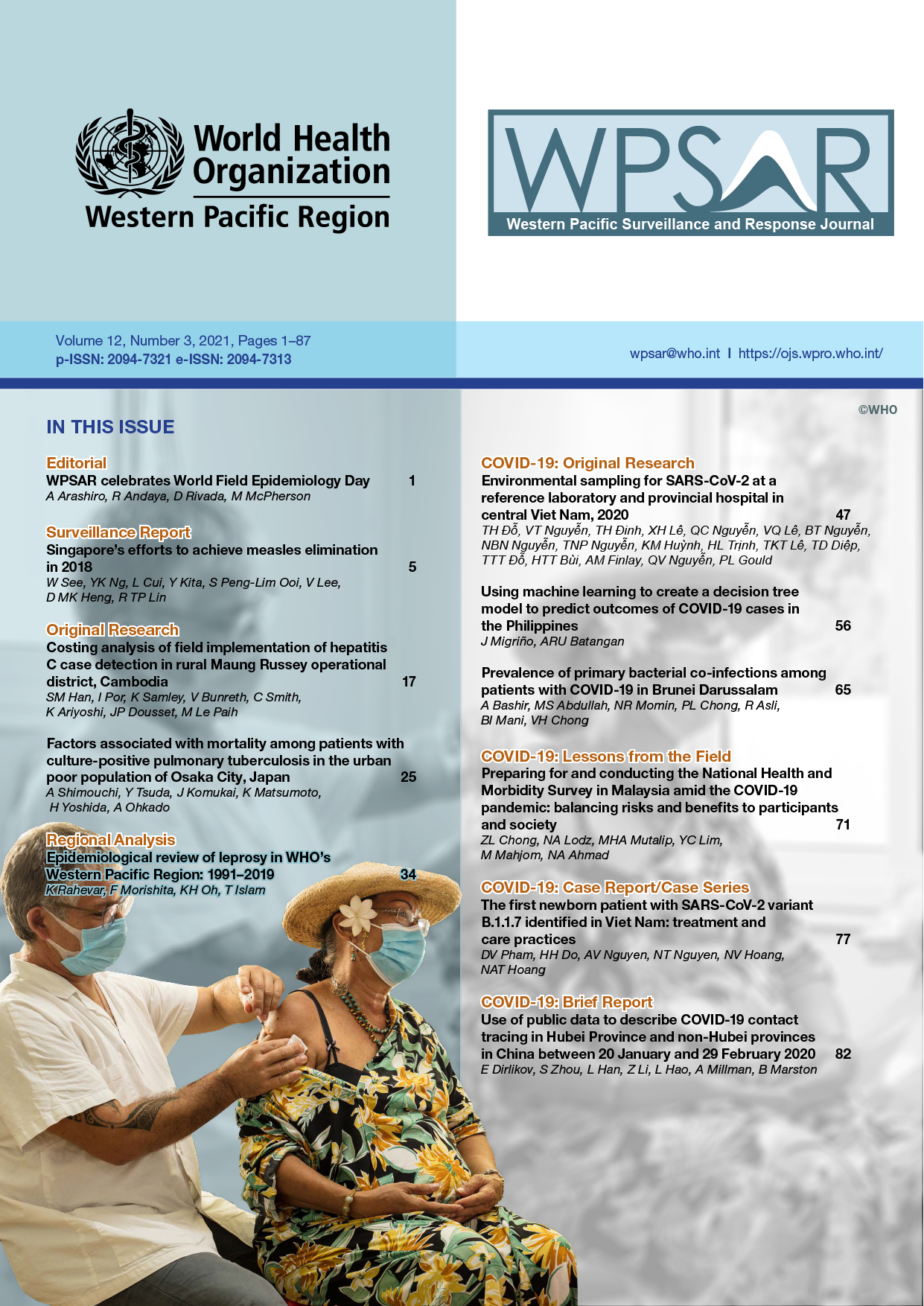Costing analysis of field implementation of hepatitis C case detection in rural Maung Russey operational district, Cambodia
DOI:
https://doi.org/10.5365/wpsar.2020.11.3.006Abstract
Background: When a new health programme is introduced, it is crucial to estimate the costs for rational health policy decision-making. The aim of this study was to determine the costs of implementing two strategies for hepatitis C virus (HCV) screening in rural Cambodia.
Methods: We retrospectively analysed clinical and cost data that were collected routinely for a demonstration project for scaling up HCV screening and testing in Cambodia. The programme data were collected between March and December 2018 in Maung Russey operational district in Battambang Province, Cambodia.
Findings: During the study period, 24 230 people were screened; 1194 (5%) were HCV seropositive, of whom 793 (66%) were confirmed to be viraemic. During the study period, 18% of the estimated population of the operational district were screened, of whom 45% were estimated to be seropositive and 41% to be viraemic. With passive screening alone, 8% of the estimated population were screened, of whom 29% were estimated to be seropositive and 28% viraemic. The cost per detected viraemic case was US$ 194 for passive screening alone and US$ 283 for passive and active screening combined. Labour costs (31%) and tests and materials (29%) comprised the largest proportions of the cost.
Conclusion: Combined active and passive screening per viraemic case detected was US$ 89 more expensive than passive screening alone but provided a higher yield (41% versus 28%) of viraemic cases. Therefore, adding active screening to passive screening is beneficial. Selective active screening strategies, such as targeting people over 45 years and other higher-risk groups, added value for HCV diagnosis.
Key words: hepatitis C, screening, cost
References
Polaris Observatory HCVC. Global prevalence and genotype distribution of hepatitis C virus infection in 2015: a modelling study. Lancet Gastroenterol Hepatol. 2017;2(3):161-76.
Frontieres MS. A population-based survey of hepatitis C prevalence and risk factrs in three rural districts in Western Cambodia 2019.
Sreng B, Kimcheng H, Sovann LY, Huot E. Epidemiology of Viral Hepatitis and Liver Diseases in Cambodia. Euroasian J Hepatogastroenterol. 2015;5(1):30-3.
Nouhin J, Iwamoto M, Prak S, Dousset JP, Phon K, Heng S, et al. Molecular epidemiology of hepatitis C virus in Cambodia during 2016-2017. Sci Rep. 2019;9(1):7314.
Piseth Narin., Nobuyuki Hamajima., Samnang Kouy., Tomoya Hirosawa., Sokha Eav. Characteristics of Liver Cancer at Khmer-Soviet Friendship Hospital in Phnom Penh, Cambodia. Asian Pacific Journal of Cancer Prevention. 2015;16.
Chassagne F, Rojas Rojas T, Bertani S, Bourdy G, Eav S, Ruiz E, et al. A 13-Year Retrospective Study on Primary Liver Cancer in Cambodia: A Strikingly High Hepatitis C Occurrence among Hepatocellular Carcinoma Cases. Oncology. 2016;91(2):106-16.
Ministry of Health C. National Strategic Plan for Viral Hepatitis B and C ( NSP 2020-2024), Cambodia 2020.
Schroeder SE, Pedrana A, Scott N, Wilson D, Kuschel C, Aufegger L, et al. Innovative strategies for the elimination of viral hepatitis at a national level: A country case series. Liver Int. 2019;39(10):1818-36.
Umutesi J, Liu CY, Penkunas MJ, Makuza JD, Ntihabose CK, Umuraza S, et al. Screening a nation for hepatitis C virus elimination: a cross-sectional study on prevalence of hepatitis C and associated risk factors in the Rwandan general population. BMJ Open. 2019;9(7):e029743.
Médecins Sans Frontières OCPO. A POPULATION-BASED SURVEY OF HEPATITIS C PREVALENCE AND RISK FACTORS IN THREE RURAL DISTRICTS IN WESTERN CAMBODIA. Médecins Sans Frontières, Operational Center Paris (OCP); 2019 18 December 2018.
Viner K, Kuncio D, Newbern EC, Johnson CC. The continuum of hepatitis C testing and care. Hepatology. 2015;61(3):783-9.
Organization WH. WHO guidelines on hepatitis B and C testing.: World Health Organization; 2017.
Yi S, Mun P, Chhoun P, Chann N, Tuot S, Mburu G. Prevalence of and risk factors for hepatitis C virus antibody among people who inject drugs in Cambodia: a national biological and behavioral survey. Harm Reduct J. 2019;16(1):29.
De Weggheleire A, An S, De Baetselier I, Soeung P, Keath H, So V, et al. A cross-sectional study of hepatitis C among people living with HIV in Cambodia: Prevalence, risk factors, and potential for targeted screening. PLoS One. 2017;12(8):e0183530.

